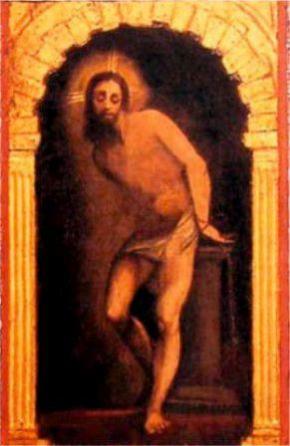 Ecce Homo, is an oil painting framed by cedarwood, 18 x 18 inches, which shows an image of Christ, 14 inches. It was painted by Colombian master Francisco Antonio, who brought it to the city in 1616, following the orders of the ecclesiastic chapter. The painting was used as the door of the side chapel at the cathedral, so it’s the most ancient painting in Cuba.
Ecce Homo, is an oil painting framed by cedarwood, 18 x 18 inches, which shows an image of Christ, 14 inches. It was painted by Colombian master Francisco Antonio, who brought it to the city in 1616, following the orders of the ecclesiastic chapter. The painting was used as the door of the side chapel at the cathedral, so it’s the most ancient painting in Cuba.Ecce homo is a Latin expression that stands for “this is the man”; words that according to the Gospel of John chapter 19, verse 5, on the Bible, were pronounced by Poncio Pilatos when he showed lacerated Jesus, who was crowned with thorns. So the name of this painting was taken from that phrase. The artwork represents Christ tied to a column and flagellated. It’s a simple composition with neutral background and a degradation of nuances. The emanating light illuminates some parts of the body, thus showing the anatomic definition given by the artist to the main figure. Light-dark nuances define the volume of his muscles and make viewers perceive the expression of pain.
The painter gets the movement sensation with other elements of the work, with great balance and symmetry. However, this marked aesthetic was not the aspect that made this painting be worshipped by the people of Santiago back in the 17th century.
Different and curious legends have been told on this Christ. People say that incredible developments took place in 1611, 1630 and 1643. On the last Wednesday of 1611 the image perspired, so it was declared a miraculous figure. The same happened on the same day in 1630 and it was even more abundant in 1643, during the mass to the Holy Spirit given by preceptor right in front of the painting. Some years later, Father Francisco Guerrero said to have heard the image repeat three times: Ecce Homo, Ecce Homo, Ecce Homo. Such supernatural events made the people call it “Holy Ecce Homo” and pay tribute on the last Wednesday of August.
Another sign of the “power” of this piece is that, in times of earthquakes or drought, it was taken in procession throughout the city to pray for protection. In 1643 the city hall got the ecclesiastic authorization to build a chapel and worship this painting, which in that time was described as a guardian patron saint in Santiago de Cuba, it was a sort of protection against attacks of corsairs and pirates.
The figure was so worshipped that the ecclesiastic city hall and the governor of Santiago de Cuba voted in 1652 to establish the participation in the holy celebration as an obligation.
Nevertheless, in late 18th century the devotion level was low. It was the result of the terrible earthquake that took place in 1776 and devastated most of the city that was so faithful.
Despite the fact that the 19th century left behind the tradition of this saint, the board the shows Francisco Antonio’s Christ is still preserved at the religious Museum of Santiago de Cuba as another element of our local history.
Source: Rafael Duharte Jimenez: “El Santo Ecce Homo: historia y leyenda” on Lo real maravilloso del santiaguero, Ediciones Caserón, 2008
Teresa Jaen Rodriguez Jaen: “El Santo Ecce Homo, la pintura más antigua de Cuba”, 2012
Previous publication Cuba Gives Critical View of Latin American Video Art
Next publication São Paulo Art Week










